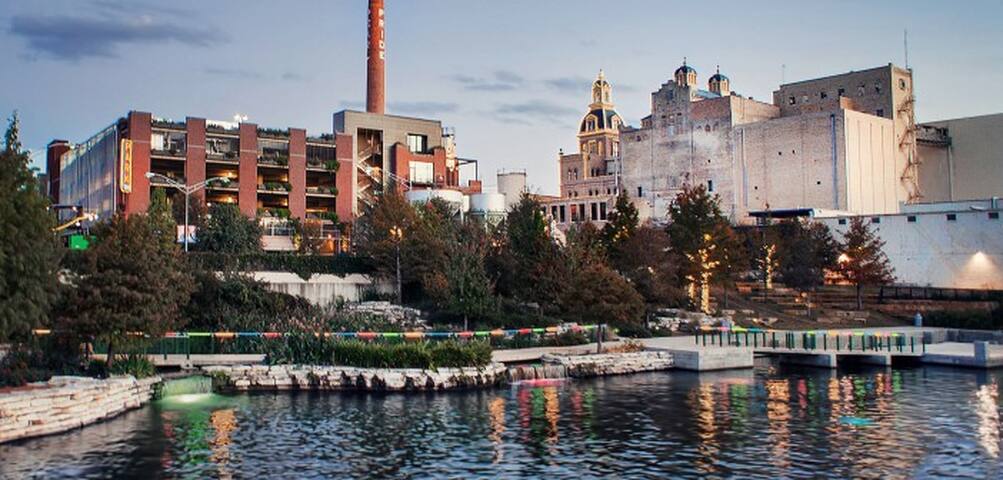Neighborhoods
Tobin Hill, to the north of the city core, is one of San Antonio’s oldest urban neighborhoods. The historic district is bounded by E. Dewey Place to the north, McCullough Avenue to the west, Evergreen to the south, and St. Mary’s Street to the east, and includes a two block section of W. Park Avenue between McCullough and Main Avenues.
In Spanish times this area between the San Antonio River and San Pedro Springs provided good agricultural land. Early San Antonio settlers dug irrigation ditches or acequias for irrigation of crops. A major acequia, the Upper Labor, was completed in 1777 and was located at what is now the southern boundary of Tobin Hill. The land abutting the acequia was distributed by lottery, with the land north of the acequia parceled out during the latter part of 1777. Due to its value as agricultural land, no real development occurred in the area for another 100 years.
In the nineteenth century, the area became known as the Old Main Association, and the land was sold to the Maverick family, Gillum & Yongue, and other large landholders. Part of the area now known as Tobin Hill was the result of an 1876 lawsuit in which the City misinterpreted the amount of land in a labor (seven acres inside city limits, but 177 acres outside city limits) and accidentally awarded Gillum & Yongue 177 acres. Gillum subdivided the 177 acres into lots, donated two blocks on either side of Main Avenue to the City for what is now Crockett Park, and sold the remaining lots. During the 1880s and 1890s, when members of the Tobin family built seven homes in the vicinity, the area became known as Tobin Hill.
Tobin Hill reflects a wide range of architectural styles including residences from late the Victorian era, numerous Craftsman bungalows, later Colonial Revival and English or Tudor style residences, and four-squares.
By the late 20th century, the campus of San Antonio College, Metropolitan Methodist Hospital and its attendant office buildings, and the construction of Highway 281 had done away with many of the dwellings. The current revitalization of the former Pearl Brewery complex, the extension of the San Antonio River Walk, and the expansion of facilities and staff at nearby Fort Sam Houston has again made the area desirable to potential residents and businesses.
Tobin Hill was designated a local historic district in two phases through City Council approval on December 9, 2007 and March 16, 2008.
17 preporuka/e lokalaca
Tobin Hill
Tobin Hill, to the north of the city core, is one of San Antonio’s oldest urban neighborhoods. The historic district is bounded by E. Dewey Place to the north, McCullough Avenue to the west, Evergreen to the south, and St. Mary’s Street to the east, and includes a two block section of W. Park Avenue between McCullough and Main Avenues.
In Spanish times this area between the San Antonio River and San Pedro Springs provided good agricultural land. Early San Antonio settlers dug irrigation ditches or acequias for irrigation of crops. A major acequia, the Upper Labor, was completed in 1777 and was located at what is now the southern boundary of Tobin Hill. The land abutting the acequia was distributed by lottery, with the land north of the acequia parceled out during the latter part of 1777. Due to its value as agricultural land, no real development occurred in the area for another 100 years.
In the nineteenth century, the area became known as the Old Main Association, and the land was sold to the Maverick family, Gillum & Yongue, and other large landholders. Part of the area now known as Tobin Hill was the result of an 1876 lawsuit in which the City misinterpreted the amount of land in a labor (seven acres inside city limits, but 177 acres outside city limits) and accidentally awarded Gillum & Yongue 177 acres. Gillum subdivided the 177 acres into lots, donated two blocks on either side of Main Avenue to the City for what is now Crockett Park, and sold the remaining lots. During the 1880s and 1890s, when members of the Tobin family built seven homes in the vicinity, the area became known as Tobin Hill.
Tobin Hill reflects a wide range of architectural styles including residences from late the Victorian era, numerous Craftsman bungalows, later Colonial Revival and English or Tudor style residences, and four-squares.
By the late 20th century, the campus of San Antonio College, Metropolitan Methodist Hospital and its attendant office buildings, and the construction of Highway 281 had done away with many of the dwellings. The current revitalization of the former Pearl Brewery complex, the extension of the San Antonio River Walk, and the expansion of facilities and staff at nearby Fort Sam Houston has again made the area desirable to potential residents and businesses.
Tobin Hill was designated a local historic district in two phases through City Council approval on December 9, 2007 and March 16, 2008.
Food scene
Incredible - don't miss the Farmers Market on Saturday and Sunday mornings
527 preporuka/e lokalaca
Pearl Brewery
303 Pearl PkwyIncredible - don't miss the Farmers Market on Saturday and Sunday mornings
Sightseeing
Old Brewhouse converted to incredible hotel - check out the bar, it is amazing!
81 preporuka/e lokalaca
Hotel Emma
136 E Grayson StOld Brewhouse converted to incredible hotel - check out the bar, it is amazing!

